Home | Mailing
List | Specifications | Care
and Feeding | Modifications | Vendors
| Literature

V8SHO Teardown - Part 1
updated 3/12/03, updated 10/12/2003
Our thanks to Robert Lookhoff for providing this information.
Getting the subframe/tranny/engine/lower suspension/steering system out in one piece is fairly straight forward.
The manual would have you leave the A/C compressor attached to the body, but I found this to be much too intrusive.
I discharged the system and disconnected the manifold line @ the A/C compressor. Leave the compressor attached to the engine.
Remove the High pressure p/s hose from the pump, remove the return feed to the reservoir.
Disconnected the steering coupler @ the firewall, where it connects to the rack-n-pinion, removed both steering knuckles from the strut base, disconnected the ARC sensors and ABS sensors, and positioned to one side, hung the brake calipers to the struts, and then lowered the car to 4 awaiting jack stands.
Disconnect the main PCM connector at the firewall, disconnect both heater hoses at the engine, not the heater core, and
misc, other connectors at transaxle. Lets not forget about the throttle cable and shift cable, heck while your their, unhooking cruise cable would ease things along,
lol.
Raise the body off of the entire assembly.
This pic took me about 2 solid hours of work.

The following picture is the assembly minus the engine, as seen on hoist in back ground, I recommend unbolting the torque converter bolts before hand, but they can still be reached from below while on the stands.

Notice how the steering knuckles sort of flop out to one side, this was detrimental in this engine replacement somehow, as after final install, created an extreme wobble under acceleration. Both axle shafts had to be replaced to correct this condition. (Notice the indentation of the right inner boot.)
I would recommend also loosening the cv axles from the spindles before hand, to avoid this.
P.S. I forgot to add remove the sway bar endlinks from the struts, but anyone performing this op, should come as a no
brainer, lol
rnlcomp@earthlink.net
Thought it only appropriate to add his narrative to this page. I'm
thinking you have know how to get it out before you can start experimenting!
Larry
As a side I asked him if he was a cam failure victim. I think everybody
will appreciate his response:
Original engine had cams welded, what got it was aviation fuel, and an already weak #7 wrist pin.
I drove it like I stole it from day one and, well, it did have 125k on the clock.
#7 wrist pin and piston decided to part ways
Seems Robert forgot to tell us something, see below:
Perhaps somewhere in the description you could add the ground cable attached to the PCM connector, and the vapor management valve connector, also located near
PCM, those were two oops I missed, and essentially had to re-splice them due to breaking them on removal.
___________________________________________________________________
Thanks to James W. Gibat-Thoroski
Jim is working on a project with the V8 SHO motor and has graciously taken
photos for us.
Four pages of text and photos, all of the V8 SHO can be seen at.
http://www.mercurycapri.com/projectrsx/v8sho/teardown.html
Enjoy, I did.
Buford
I think James gave up on his project of a turbo propane SHO V8 in his Capri
about the time the Cam issue cam to the forefront. Together we made annotations
for the photos and I will not make any deletions if if we don't plan on
transplanting the engine since perhaps the observations may be helpful if not
confusing at times.
 |
This
shows the front/passenger side of the engine, note the vertical oil filter
with the oil cooler above it. The wire near the oil filter is the oil
pressure sending unit. Coolant comes out of the block through the oil
cooler and an external line takes it to the water pump. To the left under
the oil fill cap is the AC compressor. On the other end, the rear/driver's
side is the water pump. The thermostat is in the water pump housing. Tube
going to the top of the exhaust manifold is the Secondary Air Injection
Valve tube. Above the oil filter, on the head, to the right of the exhaust
manifold is the CMP - camshaft position sensor. |
 |
This photo is of the front/driver's side of the
motor. This is with the cover removed showing the valve cover. Looking
down the center of the valve cover you can see the holes where the spark
plugs are. They are centered directly in the center of the combustion
chamber.
Hanging directly at the above right of the oil filter
is the IRMC box. This controls the secondary valves that allow the motor
to breathe more above 3500RPM. Once at 3500RPM this box opens the
secondaries, much like a carb, and allows air to pass through to the other
intake valves.
The
water pump assembly is to the right |
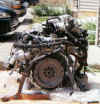 |
This
photo is of the rear/driver's side of the motor. The upper left side is
the water pump. You can see how the intake and surge tank cover the entire
passenger side/rear of the motor. You can also see the flexplate from this
angle. It has a hole through it right into the back of the crank. Perfect
for a manual transmissions! You'll notice also that the bellhousing
pattern isn't perfectly around the entire block. There is room on the
right side for a regular starter, I just hope there is enough room! |
 |
Here is the SHO V8 from the front/passenger side.
Here you can see the wiring harness to the left as well as the A/C
compressor on the right. One serpentine belt wraps around all of these
pulleys on the front. A pretty small and compact package. Directly in the
center of the motor at the top of the front cover you can see the power
steering pump without it's pulley.
Just
above the power steering pump to the left you can see the shiny chrome
fuel pressure regulator. |
 |
This
is the surge tank (upside down) The large opening goes to the throttle
body. For our project however, a large stainless steel tube will be
entering here from the twin turbos. This is actually a great intake for
the project as all you have to do is form the pipe and clamp it on. Also
with the way the intake is made it might be pretty easy to shorten or
lengthen the intake runners to tune the motor for high or low RPM. |
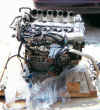 |
This shows the rear/passenger side of the engine. The
four circles through the center of the valve cover are the coil-on-plug
ignition coils. I would LOVE to keep these coils if I can for our project
but I am not sure if I'll be able to get an ignition system to work with
it as the original SHO V8 ignition was all controlled by the EEC-V. I am
going to try and work something with Electromotive if I can. Perhaps they
can ship me a unit without their coils and set something up that will fire
my coils instead.
You can see most of the wiring harness here.
On
top you can see the individual runners into the intake. The surge tank
clamps on to these. |
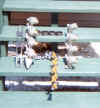 |
These are the upper intake manifolds. Pretty simple.
I think it might be pretty easy to get a set of custom intakes made and
mount a few downdraft Webbers to them.
The orange things in the middle are the 19 lb/hr fuel
injectors which screw into the lower intake manifold.
Note
the odd oval shaped holes in the gasket - oval for the siamese intake
ports in the lower intake manifold. The manifolds come down to the IMRC
and then it widens to allow air into both intake runners for the valves. |
 |
This is the top view of the engine showing the IMRC
manifold in place. The two rows of holes down the center are where the
fuel injectors push in. The right/passenger side of the engine is closest,
note the dipstick on the far side. The close side shows the secondaries
being closed. These lead to the secondary intake valve. These are the
secondaries that open at about 3500 rpm. They are larger than the primary
intake port though the intake valves are the same size. Some say this
valve closes near redline to limit RPM and keep the SHO Taurus out of
trouble. In our project this won't be a problem as the Electromotive unit
will have a rev limiter.
This is the IMRC intake manifold removed from the
engine valley. It still has the IMRC deactivation motor attached. Note the
gaskets have a relief on one port for the fuel injector. This allows the
injector to get a straight shot at the intake valve. This will be of no
value in our project. I will get the ports ported as best I can. I've even
thought about bigger secondaries. Shouldn't be hard to port out the IRMC
and add larger butterflies from a carb of the same size butterfly.
Something to try anyways.
Soon
I will be testing the IMRC box. I want to see if you apply 12V to the box
if the secondaries will open. I am expecting them to do so. |
 |
This is the IMRC intake manifold removed from the
engine valley. It still has the IMRC deactivation motor attached. Note the
gaskets have a relief on one port for the fuel injector. This allows the
injector to get a straight shot at the intake valve. This will be of no
value in our project. I will get the ports ported as best I can. I've even
thought about bigger secondaries. Shouldn't be hard to port out the IRMC
and add larger butterflies from a carb of the same size butterfly.
Something to try anyways.
Soon
I will be testing the IMRC box. I want to see if you apply 12V to the box
if the secondaries will open. I am expecting them to do so. |
 |
With
the lower intake manifold removed one can see the two green knock sensors,
one on each side of the box whish is the crankcase oil separator. Note
that the water pump is still attached on the left side of the photo. On
the right of the photo is a hole where the PS pump would be in the crotch
of the V between the heads. |
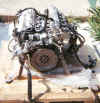 |
The mess above the flexplate is water plumbing. The
actual pump is to the left. The lower hose carries water into each head
from the water pump. The upper hose is the hot water return from the
center of the block which goes to the radiator, heater core and throttle
heater.
The
SHO V8 is unique as it sends coolant to the heads first and then through
the block. This is also found on the LS1 and LT1 V8s from Chevrolet. This
is the first and only motor to have this cooling arrangement from Ford. |
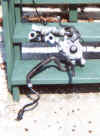 |
This is the back side of the water pump. The lower
hose carries water into each head from the water pump. The upper hose is
the hot water return from the center of the block which goes to the
radiator, heater core and throttle heater. Note the pulley, which runs off
the intake camshaft and the belt tension above it.
There
has been some controversy about the water pump being driven off the intake
cam. I am not sure if this adds any undo stress to the cam or not. I am
hoping to get an underdrive pulley for the water pump so that it doesn't
put as much strain on the motor. With a large aluminum radiator it might
relieve some of that stress. |
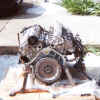 |
This is the same view as photo 11 only with water
pump removed. You can see the big holes which feed coolant to the heads,
in between them is a whole in the block you can not see which is the water
return. It is flush like a thermostat would be on a Chevrolet small block
V8.
In the center is the rear plug for the balance shaft
above the flywheel.
The 3 bolt pulley on the intake cam drives the water
pump. Note the top-heavy
Note the proportion of the block with the big DOHC
heads, and 60 degree V construction. If it were a 90 degree V it would be
wider but not as tall over all. The 60 degree V8 is much lighter and more
compact than a 90 degree V8.
This
is what we need in our project. A small, light weight, narrow, compact
engine. This SHO V8 has it all! |
 |
These
are the cast valve covers. They are not stamped steel, aluminum or plastic
like on many other motors. These are cast out of aluminum and are a lot
heavier than most valve covers. The gaskets are rubber and reusable. |
 |
Here is the passenger side/rear head with the valve
cover off.
You can see the cams, intake on top and exhaust on
the bottom. The cams are hollow tubes with the lobes glued on. The lobes
are placed in a jig and the tube is place in the center. A ball is rammed
down the center which expands the cam tube and fixes the lobes on the
shaft. A glue makes the arrangement permanent. Down the center, like a
Hemi are the 4 central spark plugs in their wells. Each little timing
chain has it's own tensioner. The oil passage from each side of the block
lubricates the tensioner first then has two galleries on under each
camshaft that lubricates each "bearing". The camshaft has no
bearing shell, the camshaft touches finished head surface.
Check out the cool webbing on the block exterior. The
aluminum block and heads are is not as strong as an iron would be of the
same dimensions. Instead of making a thicker and heavier bock the block is
webbed externally for strength which results in a engine 100's of pounds
lighter than a iron V8 of the same output.
Just
looking at it gives me technolust. |
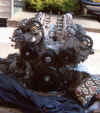 |
Missing are the AC compressor on the right, power
steering pump on top in the crotch of the V, alternator on the left and a
drive belt tensioner which lives under the alternator.
The
center crank snout pulley is the only one changed when going to an
underdrive pulley. Just above it's centerline on the right side is the
crankshaft position sensor. It maybe not visible in the shadows. One can
see the asymmetrical chain drive system. The V8 chain drive in contrast
should last as long as the car. |
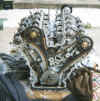 |
This is a more revealing photo of the chains that
drive the cams. The upper center in the crotch of the Vee is the balance
shaft. The intake cams are always in the center and the exhaust cams are
toward the outside. The cams must have large sprockets because the turn
only 1/2 as fast as the crankshaft. On the block, above and to the left of
the crank snout is the timing chain sprocket tensioner, which gets as much
oil as the mains. The "tube" cast into the block above the
timing chain sprocket tensioner is the oil main gallery going to the head.
Another like it is visible on the other side.
Where
the crank pulley used to be you can see the trigger pulse wheel. This is
what the crank shaft position sensor reads to tell the EEC-V where the
engine is in it's rotation. It will be replaced or reused with the
Electromotive ignition system. |
 |
This is the timing chain cover, on can see the front
main seal, where the crank snout sticks out. To the right of the front
main seal is the crankshaft position sensor.
Looking
at this, some how I will have to have motor mounts attached. In our
project we plan to have motor mount plates. Usually on normal V8s you can
attach them to the front of the head or through the front water pump. This
SHO V8 is a lot different in this respect. I am sure I will be able to
figure something out. |
 |
With the camshafts removed one can see the bucket
shims which move the valves and the tops of the sparkplugs which are way
down in the wells. No chance of them getting much air. Note the absence of
cam bearing half shells. Camshafts must be removed to access 10 bolts that
hold the head down. One can see the oil hole for the tensioner on the
left.
There
are only 10 bolts that hold down the head, which means 4 bolts per
cylinder. Pretty typical of Ford. This can contribute to problems with
head gasket sealing. A lot of SHO V8 owners probably havenít experienced
this as they are just running their stock motors. I guess we'll find out
when we put on our twin turbos. |
 |
One can see the oil separator better with the knock
sensors better in this shot and the siamese water ports to the right in
the crotch of the V.
On the head gasket surface, the large round holes are
all head bolt holes. Everything else is a water passage except the small
round hole on the left which is a oil passage. Note the abundance of water
holes on the lower side, where the exhaust valves are in the head.
Towards the right side of the motor you can see in
the center the hole in the face of the V. This is where all the coolant
comes out of the motor. The coolant flows through the heads, then the
block and comes out there.
Another
interesting note is how high the deck height is. It doesn't come up much
higher than the center "valley". On a lot of older V8s, the deck
would come up much higher. I think this gives the SHO block added strength
as it's one compact piece of aluminum without any extremities hanging out. |
 |
It may be difficult to see but the piston tops are
near flat with a small shallow dish in the center. The dish an indication
reducing the compression ratio. The combustion chamber in the head is a
measly 39cc. This is incredibly small. With a flat top piston I am sure
the compression ratio would be close to, if not over, 11:1. The stock
compression ratio is 10:1.
Note
the absence of valve relief eyebrows on the piston tops. Four valve
engines require less valve lift than 2 valve engines for the same port
flow. Oil passage is visible as small round hole on left side. |
 |
Intake valve run across the top row of the head in
this photo. Their valve stems are all parallel. The exhaust valves are
smaller and run across the bottom. Note the emphasis of cooling passages
on the exhaust side of the head. Also visible are the bucket shims and a
long head bolt. So far I haven't seen much use of studs, I looks like the
engine is put together with bolts not studs so far. I wonder what the
lower end uses. The orange thing on the right side of the head is a chain
guide.
You
can see the spark plugs in the center of each combustion chamber. |
 |
Here on can see just how high head is. On the nose of
the crank snout is the crank driven "G-rotor" oil pump. Above
that one can see the balance shaft sprocket.
You
can see how compact the block is itself. I know how the short block goes
together. This should be one strong little motor. 600 to 700 HP would
probably be the max. |
 |
Here
is a great close up of the combustion side of the head. I should be
getting some clearer ones later. Intake valves on top, center spark plug,
smaller exhaust valves on the bottom. The four round holes in the corners
are bolt holes. The oblong holes are for coolant. |
 |
Close up of the power steering pump without it's
pulley. |
Contact Information



